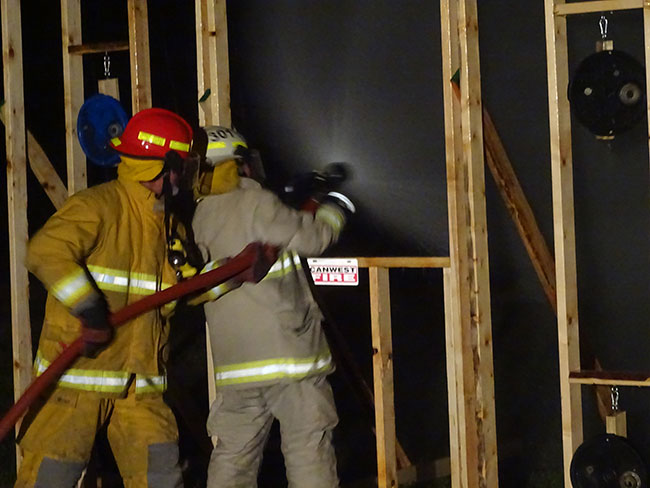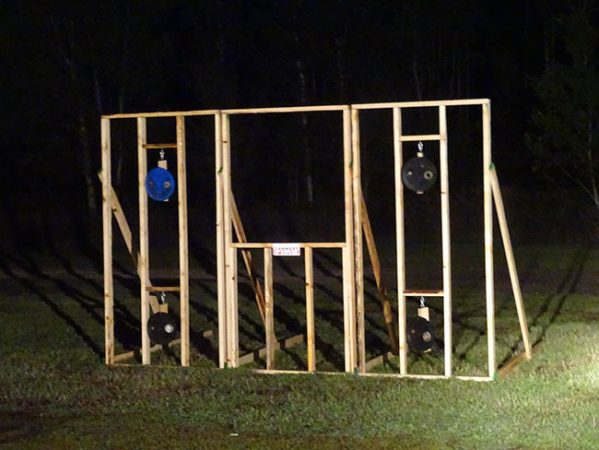
Features
Trainer’s Corner: The next generation of ICs
October 30, 2019
By Ed Brouwer
 As part of my Incident Commander training, I built an inexpensive prop with the objective of providing targets for the hose team and a window opening for “Hitting it Hard” from the yard. PHOTOS BY Ed Brouwer
As part of my Incident Commander training, I built an inexpensive prop with the objective of providing targets for the hose team and a window opening for “Hitting it Hard” from the yard. PHOTOS BY Ed Brouwer Over the last two months our training focus has been on the role of the Incident Commander. The Incident Commander (IC) is responsible for all aspects of the incident response, ensuring that operations are conducted safely. Following the Incident Command System (ICS) they are responsible for communications, incident objectives, management of resources and all persons involved.
The Incident Command System (ICS) is a standardized on-site management system designed to enable effective, efficient incident management by integrating a combination of facilities, equipment, personnel, procedures, and communications operating within a common organizational structure.
The ICS is used to manage an incident or a non-emergency event and can be used equally well for both small and large situations. For more info see icscanada.ca.
The IC is usually the first qualified person on scene, although there are times when the role of Incident Commander may be handed off to a higher-ranking officer.
I chose five members from among the responders who are consistently responding to calls during the day as candidates for our new IC Training program. We are going to spend the next few months developing their skill sets as incident commanders.
In order to build their confidence in decision making, I found a donor vehicle we could use as a prop. I set up a vehicle fire scenario and had each of the IC candidates perform the role of IC. We got everyone engaged in these exercises. Over the course of four weeks we role played using this old car. The IC candidates were expected to interact with dispatch (me on our Tac Channel). They notified me as they left the fire hall, and when they arrived on scene they were expected to give an Arrival Report.
Arrival Reports had to include on scene confirmation, incident location, building construction, fire conditions, establishment of command and critical safety information.
The IC also has the option of changing the response mode of responding resources. It may help to let dispatch and the other responders know your initial operational mode; offensive, defensive, investigative or rescue. The Arrival Report is also an opportunity to request help right away—for second/third page, mutual aid, hazmat, forestry, RCMP, EHS or utilities for example—and to warn of dangers such as downed power lines.
Answer these simple questions: Who are you? Where are you? What do you see? What do you need? What are you going to do? This short and sweet 30-second report paints a clear picture for incoming units.
Unfortunately, on scene communications are never without their issues. I realize radio protocol is elementary, but many firefighters still struggle with handling the radio with gloves on. I also witnessed firefighters not using the clip-on mic/speakers provided, choosing rather for some unknown reason to struggle getting their radio in and out of their bunker gear pockets.

As part of my Incident Commander training, I built an inexpensive prop with the objective of providing targets for the hose team and a window opening for “Hitting it Hard” from the yard.
PHOTOS BY Ed Brouwer
Just a reminder to use the word “From” — “Attack Team from IC” NOT “IC to Attack Team”. Always call out who you want to communicate to first. As well, wait until you are acknowledged by the unit you are calling before going on with your message. Wait for the go ahead. Once you have been given the go ahead, clearly and precisely communicate your message.
Playing it out as a full-blown scenario / evolution engaged all of our members. Everyone was involved in the fireground operations; scene safety, accountability, stabilization, communication, suppression, hose lays, fire streams, pump operations, scene lighting, staging, etc.
Halfway through the scenario I had the IC transfer command to another IC candidate. That new IC would continue with the scenario and then wrap things up and return to the fire hall. This was all done to build confidence in radio communications and scene management.
In order to further develop our IC candidates and provide opportunities for our firefighters to handle hose lines and water streams I built an inexpensive prop. It is built out of 26 2×4 (92”) SPF studs, four used pail lids, eight 2 5/8 eye hooks and four 1/4 safety snaps and a handful of three-inch wood screws (approximately 50). Any time you can build a reusable prop that engages your firefighters for under $100, it’s a winning situation.
It loads easily in the back of a pick-up truck and takes only a few minutes to set up and take down (as long as the battery in your screw gun doesn’t die). The objective was to provide targets for the hose team and a window opening for “Hitting it Hard” from the yard. I didn’t fill in the wall sections with plywood fearing the stream pressures would knock the prop around. The open studs worked great.
One night we set up the prop and assigned an IC, pump operator and two-person hose team. Our IC candidates took turns ordering hose teams to hit two targets (one target at a time) and then they were to approach the window and apply a fog pattern through the window in a circular motion (mimicking cooling down an interior fire from outside the building).
The IC chose two targets out of the four, (Upper Alpha Bravo, Lower Alpha Bravo, Upper Alpha Delta and Lower Alpha Delta). Then they requested the hose team to hit the chosen targets one at a time. The hose team advanced the hand-lines to approximately 50 to 60 feet from the prop wall. Once they completed the first target, they were assigned the second. They then repositioned the hand-lines and performed that required task. They were then asked to advance the hand-line to the window portion of the prop. A firefighter was called by the IC to break the glass (pretend using pike pole or axe). Have FF follow your department’s operational guidelines, keeping it as realistic as possible. Once the window is broken, the attack team will be requested to perform an interior cool down from outside. Each request was done using our radio protocols.
- IC: “Hose Team from IC”
- Hose Team: “Go ahead IC”
- IC: “Hit target Upper Alpha Bravo”
- Hose Team: “Copy that, hitting target Upper Alpha Bravo”
Pretty simple really, but I find these repetitive small steps will help build confidence and improve radio communication skills.
While I was busy with this group my assistant taught hydrant basics to the remainder of the members. This kept everyone busy and engaged. By the end of the night every member attending practice had hands on. Note: I chose not to use BA during this scenario/evolution in order to get each of our members on the hand lines.
If you would like more info on the prop just drop me a line. I hope this article will give you some more ideas for your department’s future ICs.
Please remember to train like lives depend on it, because the certainly do. Stay safe. Ed.
Ed Brouwer is the chief instructor for Canwest Fire in Osoyoos, B.C., deputy chief training officer for Greenwood Fire and Rescue, a fire warden, wildland urban interface fire-suppression instructor and ordained disaster-response chaplain. Contact Ed at aka-opa@hotmail.com.
Print this page